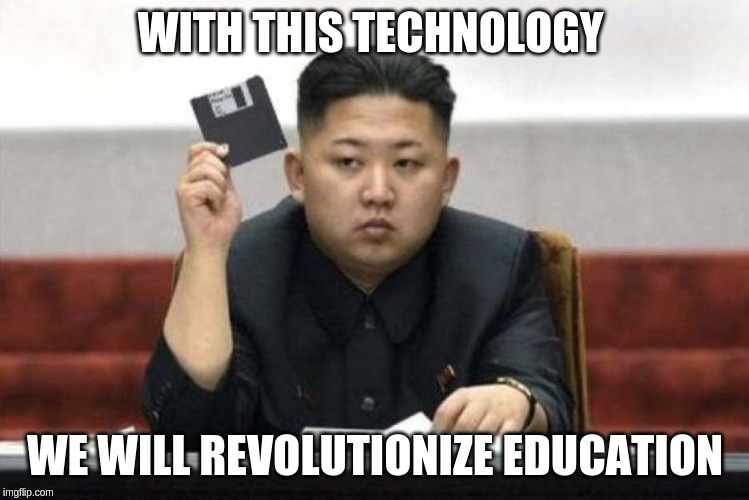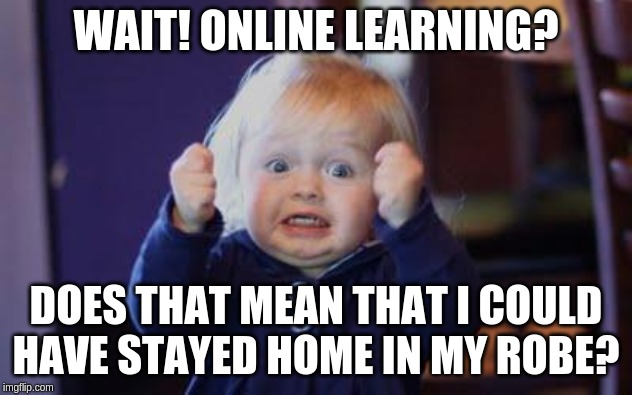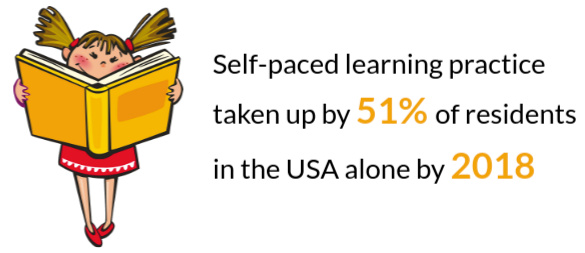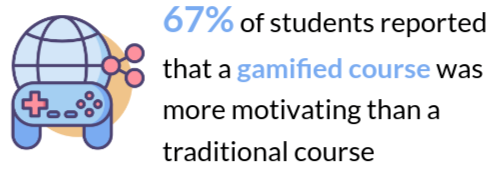“We need technology in every classroom and in every student and teacher’s hand, because it is the pen and paper of our time, and it is the lens through which we experience much of our world.” – David Warlick
There is no denying that without technology, this dynamic and vibrant world as we see it today would have never been possible. And we see this dramatic effect of technology in every sector, starting from basic immediate necessities like Housing, Farming, Electricity, Medicine to more long term impacting sectors like Governance, Defence, Education etc. Today we will inspect the effect of technology on the most long term impactful sector for any nation – “Education”.
The kids born between the mid-1990s and mid-2000s saw the most advanced and game-changing periods of technological advancements in human history. For most of them, smartphone usage is their second nature. It affects how they eat, live and breathe. So, why not how they learn?
And as you rightly guessed, technology has become quintessential in classrooms now. The worldwide e-learning market is projected to be worth $325 Billion in 2025.Technology helps both students and teachers to collaborate better, encourages them to be creative and innovative and learn new things leveraging the device they love the most, i.e. their mobile phones.
[custom-form type=2]
Digitize Your Education Business !
At BinaryFolks, we understand the importance of technology in education very well. We, in this article, will help you understand the importance of technology in education and how the whole education scenario changed with edtech.
Why Is Technology Important In Education?
[1] Education Becomes Accessible To All And Accommodates Everyone’s Needs
With technology-based learning, there is no dependency on an institution or an instructor. Additionally the fact that students can access it remotely makes education accessible for students with physical disabilities as well, since they can learn at any point in time and from the comfort of their home. eLearning also helps students get easy access to all the information related to their field of study. When these platforms leverage tools like audio to text converters, it further enhances the student’s learning experience by making spoken lectures and discussions easily searchable and accessible in text format. Finally, because of this minimum dependency, students from any geography can access the eLearning materials, thus broadening the horizons of students and exposing them to the world outside their city or country.
[2] EdTech Keeps Students Engaged
90% of kids use digital learning materials at home and 2/3 start by the age of 5.(According to the Deloitte Survey)
The first part of online learning is customer acquisition, i.e. getting students to enrol in the course. But that's not all. The primary aim of an elearning program must be to make engaging content so as these students don't opt out of the course.
Engagement in the form of video lessons, microlearning, attractive infographics or gamification will help deliver a successful online course and keep students come back for more.
[3] Technology Increases Knowledge Retention Rates
After one hour, people retain only half of the information presented to them. After one day, they forget 70% of everything they’ve learned. After a week, that no. increases to 90%. Technology helps in improving this scenario. eLearning is supposed to increase knowledge retention by 25% to 60%.
This is because visual information is captured by the brain quickly and is processed better. Using technology in education like gamification, mobile learning, microlearning, VR based learning, etc. increases student engagement and helps with knowledge retention.
Also, repetition aids retention. With educational apps, learners might be asked to attend a quiz on the module they learned earlier before jumping to the next one. Practice, indeed, makes a man perfect.
[4] Technology Builds Effective Communication And Collaboration
eLearning is all about communicating and collaborating. Such communication can take many forms – student- teacher collaboration, peer to peer collaboration and student-parent collaboration. Communication in eLearning can be synchronous (real-time) as well as asynchronous (communication over time-lag).
Interaction can happen through a variety of media, including whiteboarding, screen sharing, audio, and video.Teachers can create an online environment where students can freely ask or discuss their doubts and actively communicate, making elearning more engaging and enriching.
[5] Improve Assessment Pocess and Track Progress Dynamically
Evaluating learner’s progress over time helps educators track how they are improving and also provide valuable feedback on the progress. It helps both students and teachers set their goals and achieve them. Plus, tracking also helps teachers stay invested and measure the effectiveness of a course or curriculum by visualizing trends in student data.
With so many edTech applications already existing in the education sector, tracking also helps one understand what is working for the learners and what's not working. With the education apps, teachers and parents have access to track the marks, user completion status, no. of attempts, duration of use, etc and see how they are progressing over time. This helps keep both teachers and parents in the loop with the learner's progress and their learning trends and patterns.
[6] Students Take Ownership Of Their Education
Technology when enclosed between the four walls of the classroom, can sometimes suffocate kids. Not everyone learns at the same pace. Not everyone gathers up the courage to clarify their doubts in the class. Elearning promotes learning at your own pace. The one size fits all concept doesn’t exist anymore. And with learning becoming so accessible, nobody wants to study a curriculum that everyone already knows. With edTech, providing personalized and customized learning content is the trend.
Personalized learning means setting the pace of learning in such a way that they are optimized for every individual learner. Learning objectives and approaches, as well as content, are tailored and optimized for every learner. This helps the students set their own goals and learn at their own speed.
Students can set the quantity of materials they consume or the duration of time they need to learn (which is called self-paced learning). Self-paced learning promotes convenience and in turn, increases the effectiveness of elearning programs. For example, if you are learning mathematics, then it is quite helpful to identify the various concepts (eg. math calculator, or converters eg. AllMath)
This availability of resources allows students to personalize the learning and study at a pace they are comfortable with. Students can play, pause and re-watch a complex concept as necessary. Also, the emergence of flipped classrooms where students are provided with materials online, outside of class and are encouraged to apply their learning, through exercises in the classroom helps students learn at a pace that works best for them.
Now, of course, there is a huge array of technologies that are already being applied in the education sector to give Students a competitive edge.
Young minds are exposed to technologies every single day, at any point in time. So, when they enter the classroom, they kind of take a step backward. Ed Tech helps leverage technology and enrich the learning experience. Technologies like gamification, AR / VR, smartboards, etc are not only changing the process of learning, it’s revolutionizing the whole education structure and bringing the world into student’s fingertips. Let’s take a quick look at some applications of edtech that are transforming teaching and learning :
Applications Of Technology In Education :
[1] Artificial Intelligence
It all began with business automation, then voice assistants and now Artificial intelligence is changing the classroom too. AI makes education much more flexible and perceptive. It is already present in eLearning and has reimagined how subjects are taught across every level of a student’s educational journey, starting from a preschool student to maybe a pre-med degree and even beyond! But how does it change the typical way of learning? Say, a chatbot that asks questions on someone's response or changing the difficulty level w.r.t the responses. While previously a single teacher had to address an entire classroom of students, AI can analyze the individual student’s intent to provide them customized content and provide them with feedback too. AI can also analyse large scale student’s data to track continuous progress in real time which helps teachers to get the complete behavioral-progress report for each student. So, with AI driven technology, teachers can improve competitive learning experience for the students.
[2] Integration Of AR And VR In A Device
Immersive and interactive learning with the help of augmented reality and virtual reality ecosystem helps revolutionize learning. An example of this is Zspace. Zspace let users manipulate objects by picking them up, rotating them, sizing up or down and changing the object’s color or shape. Also, users can view the objects from any angle and simulate the perception of depth.
[3] Smartboards
A smartboard is an interactive whiteboard. It allows different forms of media (Images, videos, graphs, etc) to be displayed and interacted with. As it’s a touch board, multiple students can interact with it at once. Smartboards facilitate hands-on and enriched learning experience by projecting visual elements. Making learning fun again!
[4] 3D Printing
Imagine having a cube in hand and being able to print out 3D models of that cube to find out its dimensions and surface area. What a treat it would be! 3D printing does just that.
Students can print out maps, topography, human organs, atoms, and molecules and get a tactile feedback of the concepts. Using 3D printing in schools acts as a visual aid for the learners and keeps them engaged. This makes learning effective, interactive and enjoyable. This also stirs creativity in students because now they have the opportunity to experiment with ideas, visually on a hands-on basis.
[5] Game-Based Learning Platform
Building a sense of play around problems encourages students to engage more. Game-based learning infuses the learning process with fun. This also motivates learners to do better at every stage of the process.
Game-based learning in the form of a quiz competition amongst 3 groups in a class and assigning points based on that or badges and leaderboards concept to foster a healthy sense of competition can help increase student interaction along with entertainment.
Read more: How IoT is going to revolutionize education industry
Now, behind the screen or outside the classroom there is anonymity where teachers cannot track student’s activity or authenticity. And there will always be some students who will exploit the weaker links in this otherwise strong technology ecosystem. Also there will be some negative human behavioral issues as seen with the technology used in other walks of life.
What Are The Negative Effects Of Using Technology In School?
[1] Technology Addiction And Distraction :
With the continuous usage of technology, students are obtaining addiction-like behavior. If teachers can create reward based learning games which students can play outside the classroom, then students might avoid the ill effect on health while still reaping the benefits of educational technologies . Also there can be a guideline mentioning when technology should and shouldn’t be used during class to decrease distraction.
[2] Confused Between Reliable And Unreliable Data :
Because of the fake or exaggerated information on the internet, sometimes students get confused between reliable and unreliable data. Teachers or parents need to explain to the students how to access valid data.
[3] Causing Health Damage :
With the exposure of BYOD, the screen time for students also increases. This not only means eye strain, but continuous usage of computer, tablet, phone may lead to back pain, neck pain, blurred vision and many serious health issues.
[4] Disconnect Students From Social Interactions :
Always being on the phone and communicating via technology impacts a student's social behaviour. Too much screen time means not spending much time over face-to-face interaction. This is affecting their social circle as well as social skills. Encouraging healthy discussions, group collaboration, team learning and presentations might help mitigating these social issues.
[5] Opportunity To Cheat
With the help of technology in the classroom, communication is easier between students.Also, it’s not possible for teachers to continuously monitor student’s activities physically.. So, these situations sometimes lure students towards cheating. Some examples will be students sharing test paper / quiz answers, copy-pasting someone else’s work online and take credit from it, googling answers during class tests etc.
Why Does Developing Your E-learning Solution With BinaryFolks Make For A Wise Choice?
Driven by ex-engineers from Google, Amazon & Salesforce
101% Value For Money (+1 for Our Complimentary Consultation before You Spend Your 1st Dollar!)
Reviews That You Can Verify!
Safeguarded Business With An NDA
Out-Of-The-Box Innovations
Eye For Details
Questions Galore (Until Your Requirement & Our Understanding are mirror copies!)
Insight-Rich Scope Enhancement
Intense Domain Expertise
Close-knit feedback loop
In Conclusion
The overall education market is one of the largest in the world today. More than $5 trillion is spent globally each year on students in primary, secondary, and corporate learning. So, if you let your kids take an iPad to school or read from an iPad when they are at home, will their grades improve? Well, 81% of college students agree that digital learning technology helps to improve their grades.
Technology is everywhere and interlinked with our daily lives. Leveraging technology in the classroom opens up possibilities for the overall development of students. It makes learning engaging and fun. We are still in the early days of technological advancements in education – the possibilities are limitless. So if you are developing a custom eLearning solution, take a look at the factors and elements!
Read more : Technology Trends In The Pandemic Era
FAQs
Technology has been a game changer when it comes to improving the quality of learning and teaching within educational organizations. One of the most significant changes over the recent years has been the upgrade in access to information, students can access to any piece of information at just the click of a button. This provides the right tools and resources to the students that help them to develop core skills that will help them in the future.
The advantages of using technology in education include:
- 1. Access to Information
- 2. Engaging Learning Experience
- 3. Personalized Learning
- 4. Collaboration and Communication
The disadvantages of using technology in education boil down to:
- 1. Infrastructure and Implementation Costs
- 2. Privacy and Security Concerns
- 3. Misuse of Accessibility
- 4. Lack of Initial Digital Literacy in Some Parts of the World
The top 3 benefits of education include –
- 1. Access to Information: with the growth in technology, students from all across the world stand on common ground when it comes to information.
- 2. Interaction and Engagement: modern teaching methods, achievement-based learning, and gamification of courses have made learning a fun activity for students across every age.
- 3. Personalized Learning: artificial intelligence and other cutting-edge technologies are helping students to improve their learning experience by analyzing their individual learning patterns, instead of serving the masses with a standardized method.
Some technologies that help students with education and allow them to perform better include:
- 1. Gamification of course with achievements and rewards
- 2. Personalized Learning that goes with the student’s pace
- 3. Virtual and augmented reality help students visualize concepts
- 4. Digital Libraries help students access all the information they need













